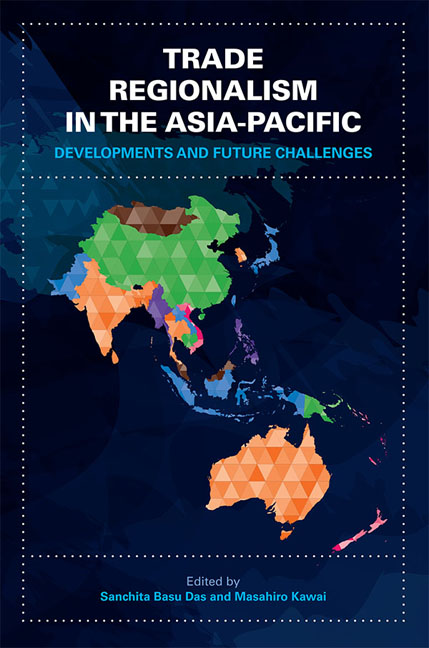Book contents
- Frontmatter
- Contents
- Foreword
- Acknowledgments
- List of Abbreviations
- The Contributors
- 1 Introductory Overview — Trade Regionalism in the Asia-Pacific: Developments and Future Challenges
- I The Trans-Pacific Partnership (TPP) Agreement
- II The Regional Comprehensive Economic Partnership (RCEP) Agreement
- III Regional Economic Integration: A Multi-stage Approach
- IV Old and Emerging Approaches to Asia-Pacific Regional Integration
- V Asia-Pacific Regional Integration: Towards Convergence?
- 15 APEC, TPP, and RCEP: Towards an FTAAP
- 16 The Implications of Mega-regional Trade Agreements on the World Trade Organization
- Index
15 - APEC, TPP, and RCEP: Towards an FTAAP
from V - Asia-Pacific Regional Integration: Towards Convergence?
Published online by Cambridge University Press: 05 July 2016
- Frontmatter
- Contents
- Foreword
- Acknowledgments
- List of Abbreviations
- The Contributors
- 1 Introductory Overview — Trade Regionalism in the Asia-Pacific: Developments and Future Challenges
- I The Trans-Pacific Partnership (TPP) Agreement
- II The Regional Comprehensive Economic Partnership (RCEP) Agreement
- III Regional Economic Integration: A Multi-stage Approach
- IV Old and Emerging Approaches to Asia-Pacific Regional Integration
- V Asia-Pacific Regional Integration: Towards Convergence?
- 15 APEC, TPP, and RCEP: Towards an FTAAP
- 16 The Implications of Mega-regional Trade Agreements on the World Trade Organization
- Index
Summary
THE FTAAP AND APEC'S REGIONAL ECONOMIC INTEGRAT ION AGENDA
The Free Trade Area of the Asia-Pacific (FTAAP) is embedded as a central element in APEC's Regional Economic Integration (REI) agenda. APEC (Asia-Pacific Economic Cooperation) was instructed in 2010 to “take concrete steps toward realization of an FTAAP” by APEC Economic Leaders, who endorsed the FTAAP as a “major instrument to further APEC's Regional Economic Integration (REI) agenda”, and laid out a vision in which the REI agenda is to create “a community … in which goods, services, and business people move seamlessly across and within borders, and a dynamic business environment is further enabled” (APEC 2010). In their 2012 statement, APEC leaders repeated their endorsement of the FTAAP as a “major instrument” for furthering APEC's REI agenda (APEC 2012), and reaffirmed in 2013 their “commitment to achieve a Free Trade Area of the Asia Pacific” (APEC 2013).
The APEC leaders’ commitment to an FTAAP has been repeatedly echoed by the APEC Business Advisory Council (ABAC), notably in their 2013 Report to APEC leaders, emphasizing that an FTAAP “will provide the best mechanism for sustaining regional economic integration” and recommending that the leaders “ensure that substantive progress continues to be made towards an FTAAP as a means for achieving regional economic integration and the Bogor goals of free and open trade and investment in the region” (ABAC 2013). Further recommendations aimed at accelerating progress toward an FTAAP were presented in the ABAC';s 2014 report to APEC leaders.
As is well known, the APEC leaders’ 2010 statement envisaged that an FTAAP would be pursued by “developing and building on ongoing regional undertakings, such as ASEAN+3, ASEAN+6, and the Trans-Pacific Partnership, among others”. The Regional Comprehensive Economic Partnership (RCEP), whose participants are identical to the “ASEAN+6” group, has superseded the earlier “ASEAN+3” and “ASEAN+6” concepts, so that the Trans-Pacific Partnership (TPP) and RCEP are now firmly established as what Petri, Plummer and Zhai (2012) call the “trans-Pacific track” and the “East Asian track”, respectively, toward an FTAAP.
Over five years of TPP negotiations concluded in October 2015. The RCEP has been under negotiation for almost three years. No formal discussions as to how these two initiatives could evolve into an FTAAP are yet known to have occurred.
- Type
- Chapter
- Information
- Trade Regionalism in the Asia-PacificDevelopments and Future Challenges, pp. 297 - 322Publisher: ISEAS–Yusof Ishak InstitutePrint publication year: 2016

